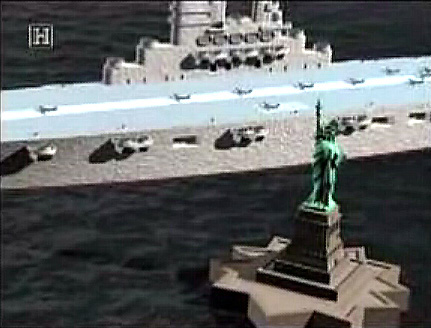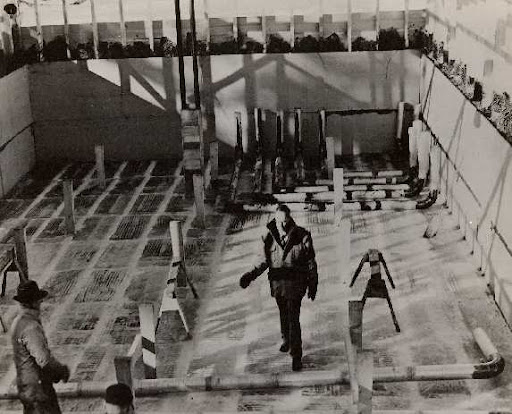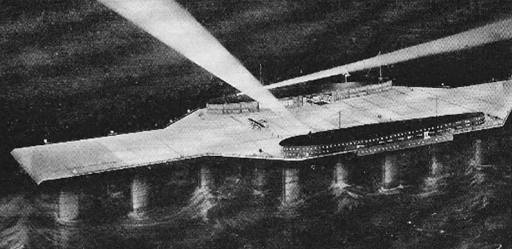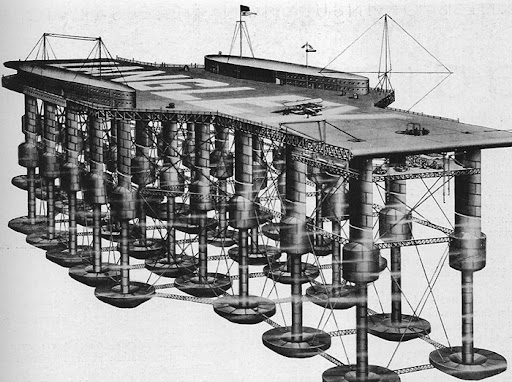 "QUANTUM SHOT" #344
"QUANTUM SHOT" #344
linkPotentially the Biggest Ship in the WorldText by M. Christian ("Meine kleine fabrik" - home for some odd, weird, and wonderful things stumbled across or tripped over: art, history, machines, heroes, movies, music, and more.)The 2,000-foot long monster "iceberg-ship" - displacement: two million tons!
 Art courtesy Dominic Harman
Art courtesy Dominic HarmanFrom the mythological specter of the doughboy who can only breathe mustard gas, to the coincidence of the crossword puzzle containing the code words for the Normandy landing, conflict can bring out both the best, and the downright strangest, in human behavior and belief. So much so, that it would take much more than this little slice of cyberspace for me to outline them all: the American kamikaze bats with their still-classified incendiary explosives, the stone-skipping delivery of the British dam-busting bombs, the around-the-corner Nazi submachine gun, Patton's phantom army, and the War Magicians, which is one of my faves: a group of British dance-hall conjurers who put their slight-of-hand talents to work making tanks into trucks, trucks into tanks, everything else into something else, all to trick the Axis.
One of my all-time favorites, though, was the one that just, almost, nearly happened:
Massive white slabs of steaming ice, churning through the sea, carrying hundreds of aircrafts
 (images credit: History Channel)
(images credit: History Channel)But before I reveal this glorious monument to inventive mania, a little about its inventor.
Geoffrey Pyke - An Eccentric, Quirky InventorLike many British eccentrics,
Geoffrey Pyke at first appears normal when viewed through Who's Who, but a closer examination always starts the head shaking. Not to say that Pyke didn't give his all and then some to the war effort - not at all. But it also would be incorrect to say that what Pyke did give could be called, at best, quirky - and, at best, bizarre.
 (image credit: hrvatski-vojnik.hr)
(image credit: hrvatski-vojnik.hr)Apprehended trying to sneak into Berlin during the first World War, Pyke was sentenced to a prison camp. By noting that
sunlight momentarily blinded his guards every day at one certain location, Pyke managed to escape, becoming something of a celebrity by accounting his daring escapades after the war.
Assigned to the War Office during the second great conflict, Pyke threw himself into devising all kinds of clever (and even often practical) means of aiding the war effort. Stretcher-carrying sidecars for motorcycles? That was Pyke. Pedal-powered shunt cars for railway yards? Pyke. Marking a special motorized cart British commandos were to use with
"Officer's Latrine" in German on them -- so the Nazi's would leave it well alone? You guessed it ... Geoffrey Pyke. Disguising British
agents as avid golfers, and then sending them all throughout Germany to secretly gather signatures on a poll to convince Hitler that his people didn't want to go to war? You guessed it. Like I said, quirky at best.
The Problem: Counter the German Submarine FleetBut the concept that propelled Pyke from simple, fascinating, oddity to the military limits of the delightfully absurd was the one he hit on while pondering one of the great problems of the Second World War: that allied shipping was being literally cut to pieces by the merciless, and precise, German submarine fleet. Even Kaiser with his smooth assembly line of cheap shipping couldn't compete with the appetites of the Wolf Packs. What was needed, Pyke considered, was some kind of strong military presence,
a way of providing air cover for the desperately-needed merchant ships.

But there were a lot of Liberty Ships, far too many to cover with even a token fleet. Not only did those transport need protection, but they needed cheap and easy protection, something simple to assemble, able to carry long-range aircraft, and not so expensive as to draw valuable resources from the battle fronts.
It would be easy to imagine Pyke sipping something cool when inspiration struck. But what really causes the head to shake is to remember that Pyke was a great British eccentric, and Brits (as anyone who has visited the UK can attest) are completely alien to anything tall, cool, and – especially - frosty.
Maybe it was watching winter slabs majestically move down the Thames, or pale masses of crystals sluice down a gutter, but whatever the inspiration, Pyke had his vision. But before it could be put into anything even close to reality, Pyke had to solve one fundamental problem: ice melts.
Icebergs that look like Navy ships/ aircraft carriers:
 (original unknown)
(original unknown) (image credit: Heritage Expeditions)A marvelous, gloriously absurd vision:
(image credit: Heritage Expeditions)A marvelous, gloriously absurd vision:
iceberg battleship/aircraft carriersPyke's vision was a marvelous, gloriously absurd one: 300 feet wide, 2,000 long mid-Atlantic runways. Displacing 1,800,000 tons of water (26 times the Queen Elizabeth), they would carry aircraft, munitions, crew, and - naturally - a refrigeration system that would guarantee that their 50 foot walls wouldn't fall to their greatest enemy (even more than Germany): heat.
These iceberg battleship/aircraft carriers would have been
the stuff of nightmares: massive white slabs of steaming ice, churning through the sea, a flurry of aircraft and support ships darting around their bulk. The Germans, my guess, would quake in fear more from the audacity and insanity of their concept than any weapons they could carry.

 (image credit: kirchersociety.org)Strange Dream of a Frozen Navy:
(image credit: kirchersociety.org)Strange Dream of a Frozen Navy:
Project HabbakukBut these tamed bergs wouldn't just depend on their mass and aircraft to defeat the German hordes. No sir, these were fightin' icebergs! Pyke envisioned a special system mated to the refrigeration equipment so the bergs could
spray out supercold water, literally freezing enemy forces in their tracks. Code named
Habbakuk after a character in the Bible known for saying: "Cast your eyes over the nations and be amazed, astounded. For I am doing something in your own days that you would not believe if you were told it" (Hab 1:5)
"The Habbakuk" size comparisons:
- with normal ships:

- with the Statue of Liberty:

But there was that big stumbling block to Pyke's incredible plans: his terrifying, freezing giants of the sea would turn to mid-Atlantic slush before ever encountering the Germans. The humiliation alone of having to scream for help as your ship literally melted around you was more than any sailor should ever bear. So, how to make nature act ... unnaturally?
New Bizarre Material - PykreteThe answer actually came from Max Perutz, who named it after Pyke: take 14% sawdust and 86% water, freeze, and viola: a bizarre material you can saw like wood and won’t melt. Well, okay, it actually will melt, but just a helleva lot slower than regular ice.
Pyke was so excited by this frosty invention that he showed the stuff to Lord Mountbatten, who was so similarly afflicted that he rushed into Winston Churchill's bathroom and in a scene too close to Monty Python to be anything but real, dropped a block of the stuff in the PM's bath water. Maybe it was the audacity, the lunacy, of the idea, or some unknown properties of Pykrete, but Churchill caught the bug: Pyke and his iceberg navy got the go-ahead.
 (image credit: combinedfleet)Building the Monster
(image credit: combinedfleet)Building the MonsterA site was found, a secret boat-house on Patricia Lake in Jasper, Alberta, Canada, and a small-size test was organized. Pyke was ecstatic as his materials were assembled into a model of his cold revelation. As a testament to either Pyke's brilliance or the twisted humor of the universe, the ice ship was a complete success: in other words, it didn't melt all through a hot summer.

 (images credit: stormy.ca)
(images credit: stormy.ca)The first layer of the ice blocks are in place. The corner pipes are being installed:

The second layer of Pykrete blocks are laid and the vertical coolant pipes are in place:
 (images credit: National Archives)
(images credit: National Archives)Alas, the landings at Normandy made the ice ships unnecessary. It's easy to imagine Pyke, face beaming in joy, standing on the frigid deck of his dream ship, envisioning its monstrous kin rolling through surging seas, throwing cascades of freezing death at the German Navy, just as somewhere else in the world the war was turning away from needing their frightening, protective presence.
As to what Pyke did after the war, it's hard for me to say: his strange dream of a frozen navy lasting longer than anything else he contributed. But one thing I can guarantee: Pyke could never see the onset of winter without thinking of his great ships, and the battles they might have won.
See this video for more pictures and historical "Ship of Ice" coverage:
urlAnother "History Channel" coverage is
here (second part of the video)
UPDATE:Another Aircraft Carrier on Steroids: The Seadrome
It was supposed to be an airplane stop in the middle of the Atlantic - a titanic aircraft carrier 1,100 feet long, 340 feet wide at the middle. The original plan from 1930 required eight such bases to be built, spread across the ocean:

Of course such stopping points for Transatlantic flights were made obsolete by the emergence of long-range airplanes.

The model of the Seadrome built at 1/32" scale and tested at Chesapeake Bay:

Source: December 1930 edition of "The American Architect",
EnigmaFoundry+StumbleUpon 
Permanent Link...
 Category: Boats,MilitaryRelated Posts: Biggest Ships in the World
Category: Boats,MilitaryRelated Posts: Biggest Ships in the World,
Flying Submarines!Dark Roasted Blend's Photography Gear Picks:























































